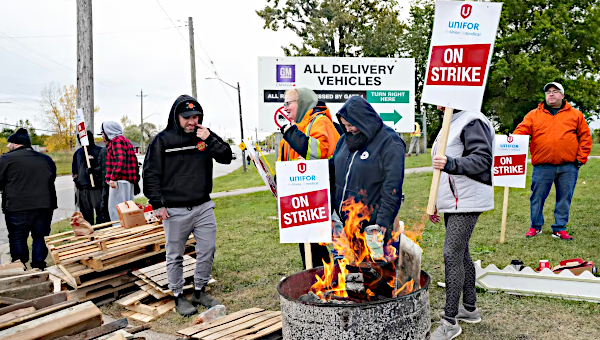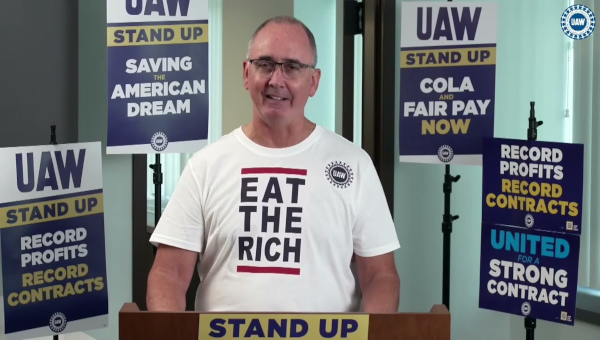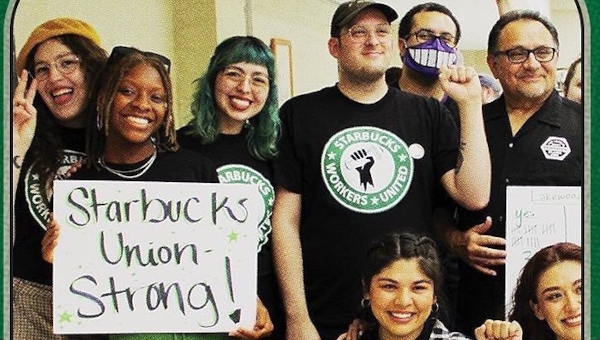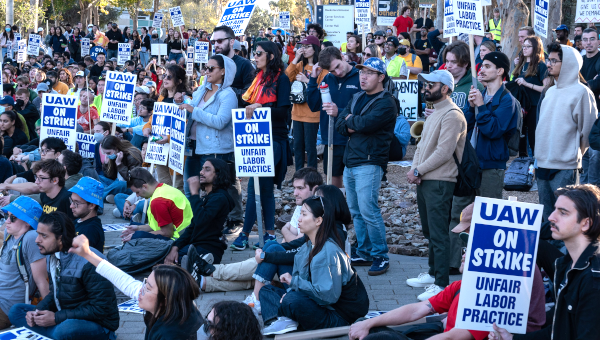For a number of reasons, U.S. unions are on the defensive – from concerted attacks by employers, the political and cultural effects of 30 years of neoliberalism as well as their inability to build resistance in workplaces and communities. The unionization rate in the private sector is down to 6.7 per cent and a central pillar of union strategy has been to organize the unorganized. The United Auto Workers (UAW) – which lost tens of thousands of members in the past decade – has emphasized the centrality of organizing non-union foreign-owned auto plants, recently located in the almost completely non-union and politically conservative south. The strategy was to make a breakthrough in one plant, and build from there.
The Volkswagen plant in Chattanooga, Tennessee was their key target. The union worked out a deal with the company, supporting the concept of Germany’s ‘works councils,’ and a series of agreements, to gain the company’s neutrality in what was to be a three-day vote. The agreement included the union’s acceptance of forms of partnership with the employer, a verbal commitment to keep wage costs below that of the Detroit Three, and evidently, promises not to engage in house visits with perspective members. As well, there was little organizing in local communities – something absolutely essential in a culture hostile to independent unionism, with low-wage workplaces, high unemployment, and general support for conservative ideas.
The union lost the vote, 712 to 626. It was a major defeat for the union, and has become a key point of debate across the labour movement and the left. While the union blamed right-wing politicians and ‘outsiders,’ it is clear, as Sam Gindin emphasizes in this cite>Bullet, that the reasons for the defeat, and its implications are much more complex and require a broader rethinking of union strategies and politics. Though levels of unionization in Canada have not hit the lows of the U.S., the need for a profound rethinking applies as well to the Canadian trade union movement.
For those of us who continue to believe in the potential and importance of the working-class to the eventual transformation of capitalism, it is easy enough to explain away the majority vote against unionization of the VW plant in Chattanooga as a failure of the UAW bureaucracy. But that is too easy. Unquestionably, and for reasons that go beyond the particular strategy adopted here, the UAW leadership must not be let off the hook. But neither should dumping on that leadership divert us from harder questions that run from the contradictions within a rank-and-file the left so often romanticizes, to the frustrating marginalization of this very left in worker struggles.
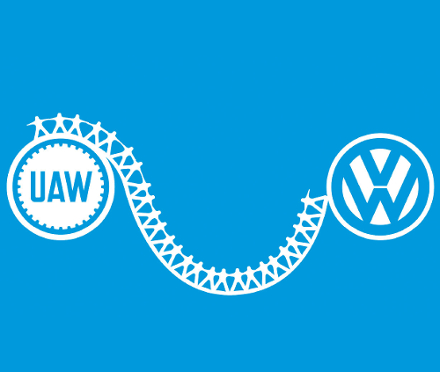 If we expect workers to one day rebel against something as overwhelming as capitalism and as intimidating as the capitalist state, how do we explain the inability of workers to take on the relatively more modest challenge of the betrayals of their own elected leaders? If the vacuum of effective leadership in unions has become so clear, why has the left not been able to rise to greater prominence within working-class institutions and in worker struggles? To ask such questions is not to excuse an inexcusable union bureaucracy but to acknowledge how complex and long-term the struggle for working-class emancipation will really be, while taking seriously workers as they currently are and demanding more of the socialist left.
If we expect workers to one day rebel against something as overwhelming as capitalism and as intimidating as the capitalist state, how do we explain the inability of workers to take on the relatively more modest challenge of the betrayals of their own elected leaders? If the vacuum of effective leadership in unions has become so clear, why has the left not been able to rise to greater prominence within working-class institutions and in worker struggles? To ask such questions is not to excuse an inexcusable union bureaucracy but to acknowledge how complex and long-term the struggle for working-class emancipation will really be, while taking seriously workers as they currently are and demanding more of the socialist left.
The UAW defeat in Chattanooga has stimulated deeper discussion of these issues and the comments that follow both borrow freely from, and sometimes disagree with, the thoughtful observations of other comrades engaged in the postmortems of labour’s latest failure.
1. Would a UAW victory have represented a reversal of the American labour movement’s downward slide?
Absolutely not. The crisis of American labour isn’t about numbers but about limits that were already there when unions were at their peak in the 1950s, the profound defeat suffered by the labour movement from the 1980s on, and the nature of unions’ response to that defeat. As Gregg Shotwell has emphasized, the UAW sold its union soul long ago and a victory in Chattanooga might only have consolidated its betrayals. This may seem harsh but it’s important to emphasize that the problem is not concessions per se. That workers may not be strong enough at particular moments to hang on to past gains isn’t itself a condemnation of their unions. The issue, rather, is the nature of concessions: two-tier wages define young workers as second class citizens and undermine future solidarity; shifting the responsibility for health care from corporations to workers without moving on to lead a crusade for single payer surrendered an opportunity to transform a loss into a lesson learned and a new mobilization.
The union’s appeal at VW amplified all this. The UAW wasn’t acting as a potential agent of workers but as the industrial arm of the corporation. This wasn’t an organizing drive to give voice to workers’ needs, but a campaign to assuage corporate concerns that the union would threaten its competitive advantages. The message was, of course, not confined to the company and media; it also flowed to the workers, suggesting that their well-being rested on strengthening ‘their’ corporations rather than themselves. This was enshrined in a ‘neutrality’ agreement, in which the union committed to “maintaining and where possible enhancing the cost advantages and other competitive advantages that VWGOA enjoys relative to its competitors in the United States and North America.”
The organizing drive at VW directly followed from the kind of union the UAW had become. Chattanooga was a test for a particular strategy to reverse the union’s decline in members. It was never a test for reversing that orientation.
2. Should we, therefore, cheer this defeat?
There are those who see in this defeat two radically different opportunities. On the one hand the hope that this disaster might serve as a wake-up call to the leaders. On the other, that this may be the moment to abandon the UAW altogether.
The prospects that this defeat will lead to any fundamental shift in the UAW’s direction are virtually zero. The leadership blames the defeat on the interference of right-wing politicians (which was indeed appalling in its dishonesty) and seems to be looking at a legal appeal to the NLRB – something with no chance of success since the employer’s behaviour isn’t being challenged and the NLRB has no jurisdiction over what third-parties say (if anything, the UAW should itself have engaged with ‘outsiders’ to the bargaining relationship, but outsiders in the form of community support). UAW president Bob King is already insisting that the union ‘will not be deterred,’ which is to say it will just have to try harder rather than differently. Since organizing strategies are inseparable from the nature of the union itself, such strategies will only change alongside an internal revolution in the union.
As for giving up on the UAW to the extent of declaring that no union is better than a lousy union, this certainly strikes a populist chord but misreads both labour history and the moment. There are lessons to be learned from the CIO’s breakaway from the of AFL in the 1930s, but one particular lesson is that the new organization was only accomplished on the base of already existing unions like the mineworkers and in the context of a relevant (communist) left – a context that isn’t there today. Moreover, decades of experience in the American south, where black activists (including refugees from closed UAW plants in Detroit) have long been trying to form new unions with unfortunately little to show for it, point to how difficult it is to start from scratch. And as frustrated as most workers are with the UAW, a good many workers still feel that even a union as weak as the UAW offers more protection than what exists in non-union workplaces. The parts sector is a case in point. It was long a conservative force in the union because of its dependence on UAW headquarters – a dependence which reflected that, for all the unhappiness with the union, the link to head office mattered because the locals got something material out of it, however small.
Finally, we should recall that the VW drive was not initiated by any spontaneous clamor on the part of workers for collective representation; it was an initiative of the UAW. Given this lack of interest in a union, and appreciating what it would take for workers to establish a union in this plant with the workers on their own against one of the world’s largest multinationals – and then what it would take to sustain the struggle on their own – it seems more realistic to join the UAW and struggle to reform it. This is, nevertheless, not an absolute; as we note further on, the question of eventually creating another auto union beyond the UAW can perhaps no longer be completely dismissed.
Those of us who hoped the UAW would win in spite of itself (I include myself) justified this not on illusions about what was likely to follow, but on the very slim hope that if the UAW did win the vote, the seeds of a positive dynamic might become slightly more possible. That is, with some structures and higher expectations, workers might at some point develop the confidence to rebel against the company and the union, and might also affect the social climate in the community. (The situation at WalMart and in the fast food industry is not quite comparable, but the struggle for a union there has generated excitement across the country even though the main unions involved behind the scenes, SEIU and UFCW, are hardly examples of a new unionism led from below).
3. Why did the UAW lose? Especially when it got the neutrality that it (and the left) had been emphasizing as critical for so many years?
We can’t say for sure. But comments from VW workers calling in to radio talk shows or circulating emails are instructive. First, as Mike Cannon, once a prominent figure in the New Directions opposition to the UAW leadership has emphasized, the role of politicians and the hostile culture of the U.S. south aren’t surprises (see Rich Yeselson, “After Chattanooga”). These were central to why VW came to this part of the country and any organizing drive should have expected this as a matter of course and planned for it. Addressing this would have meant not just talking to the workers but to involving them in the kind of mapping and mobilization of the community that Jane McAlevey emphasizes. This would include confronting right-wing politicians with a political campaign over the kind of community desired by working people rather than the chamber of commerce.
Second, it is surprising that any workers wanted a union that promised them so little. As one put it, “What the UAW is offering, we can already do without them.” The union didn’t promise higher wages but it could have spoken in terms of matching standards in the industry rather than maintaining the lower costs at VW. It never addressed two-tiers, leaving VW workers –
who repeatedly raised – wondering if they too would face these kinds of concessions. And it didn’t promise changes in workplace relations and conditions (the crucial issue in most union drives) which would in any case have been problematic because the union had such little credibility to do so since the UAW has for years been sacrificing workplace rights for wages and benefits.
So again, the very nature of the union undermined effective organizing. The point here is not that workers are generally organized around radical demands; workers considering whether to have a union or not tend to see this in narrowly instrumental terms – what can this do for me – and it is then up to the union to develop greater confidence in broader perspectives. The problem rather is that in its strategic dependence on signing a neutrality agreement at any costs, the UAW could not even sustain the instrumental role of unions.
Third, the union, bizarrely, accepted a passive response to even talking to workers in their homes and outside formal meetings organized with the company: “The UAW agrees that it shall not approach or seek to speak with Employees who do not approach it.” (Neutrality Agreement, p.8.). This is not just a strange way to organize workers, but it excludes workers – never mind the community – from the process and reinforces the distrust that is a barrier to bringing workers into the union.
4. Was the focus on VW misplaced?
Nicole Aschoff has suggested that the UAW needs to forget about the big breakthroughs and concentrate on building in the parts sector, where the need for a union is more self-evident. This is an interesting idea and it can be made even more interesting if we note that the potential power in the industry has, because of outsourcing, actually shifted to parts – one component plant can now shut down multiple plants across multiple companies. But to use this power, the union can’t just keep going back to the same plant – the companies would just move to a different supplier. It would need to be coordinated and done selectively so as to exploit the fact that the auto majors can’t move away from all the parts plants without leaving the United States.
But this just highlights the actual problem. Such a strategy demands both challenging the corporations, not trying to make them stronger and a culture of solidaristic wages across plants. The UAW could have used this strategy to fight the parts companies and the assemblers in bargaining, but didn’t want to raise the cost of components and go to war with the Big Three. It could have used the threat of shutting down non-union assembly plants by cutting off components as a way of achieving corporate neutrality in giving workers a free vote (rather than buying that neutrality with promises of ‘responsibility’).
The point again is that the real issue isn’t organizing tactics but transforming the union. This can only happen if a class sensibility is included in union understandings and strategizing (which is in turn linked to democracy, militancy, an educational grounding in capitalism and capitalist states, etc.).
5. But don’t the plants have to be competitive?
The competitive threat facing manufacturing workers is real; it cannot be dismissed with a wave of the hand. But it is one thing to acknowledge that competitiveness is a constraint within capitalism and another to sell it as a union goal. For unions the challenge is how to stretch or overcome that constraint through limits on the corporate power to unilaterally close facilities). The UAW has however accepted, endorsed, and committed to the framework of competition in away that inevitably undermines solidarity rather than struggles with balancing worker needs and capitalist reality.
In the particular case of Volkswagen, the plant is new and productive. VW wants to be in the U.S.; just like other transplants it sees having a base in the U.S. as a strategic necessity. To pull out would undermines that strategy. To close this plant because a union added some costs would be economically stupid. Even if the plant had a failed model and was in trouble, the company would most likely try to bring another model in. This gives the facility importance not just in terms of increasing the UAW’s membership roles but as part of developing strength in a part of the industry that might in the future be the site of establishing auto industry standards.
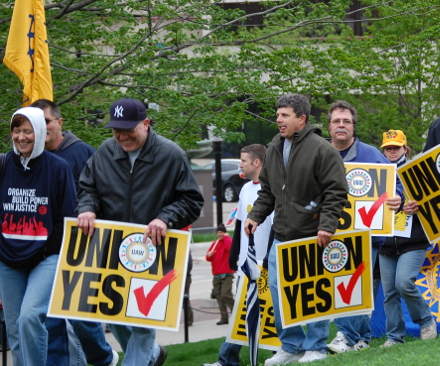 6. Does all the blame lie with the union bureaucracy? What about the workers?
6. Does all the blame lie with the union bureaucracy? What about the workers?
In raising issues that go beyond the union leadership we are certainly not trying to absolve that leadership from the responsibility it bears for the state of labour. Even if we acknowledge how difficult the times are, and set aside the specifically anti-solidaristic nature of
the concessions made, what stands out is the refusal of the leadership to initiate the kind of widespread, democratic and open discussion that might actually get us somewhere else (consider, in contrast, what is now transpiring within the National Union of Metalworkers of South Africa).
But the left too needs to rethink and that includes soberly confronting the lack of spontaneous rebellion among workers when the failures of the leadership are so blatant. We need to come to grips with:
a) The limits of sustained spontaneous rebellion from below. Workers have potential but they need structures to fight through and leadership that serves as a catalyst for developing their confidence. This once meant ‘militants’ but today, because of the polarization of options – militancy is not enough – it means socialist militants.
b) The fact that this limit to worker resistance under capitalism has been especially built on by neoliberalism with its incorporation of workers. The genius of neoliberalism is that capitalist hegemony has been achieved through worker fatalism re collective action: workers have come to accept there is no alternative than to survive through the individualized mechanisms capitalism offers.
7. Where next?
It seems obvious enough that any further organizing in the U.S. south will have to involve a comprehensive community campaign and grass roots educational work among working people inside the plants and in the community around globalization, neoliberalism and the economics of the industry. Unions have to present themselves as a social force that can address the inequalities, injustices and uncertainties of everyday life.
This demands a material base and structure and the first step at VW should be, as raised by Bill Fletcher, to establish a UAW local even if this just means ‘minority unionism’ for now to continue – or rather raise to a new level – the development of an effective union in Chattanooga. A base for this seems to exist in spite of the defeat. This would concretely raise questions about organizing strategies, worker needs, and membership participation. We cannot predict how successful this might be but it carries potentials that other options like waiting a year and trying the same thing again or expecting the divided and skeptical workers to now move to establish an independent union on their own. It might inspire – in a way that the original UAW drive didn’t and couldn’t – workers at other transplants to set up similar committees.
We should not get ahead of ourselves but – who knows? – this might stimulate discussion among UAW activists elsewhere about the kind of union that could one again give voice to their concerns. If reform failed, newer plants employing workers whose confidence and expectations are growing might then more seriously use their base to contemplate an alternative union or, coming out of the community organizing to win their unionization consider a different model than industrial unionism: regional unions across sectors (which doesn’t exclude ad-hoc alliances with other UAW locals).
8. Does this bring us back to the political state of the Left in North America?
Above all, we need to bring our discussion back to the role of the left role. A degree of humility on the part of the left is in order here. Yes, union bureaucrats aren’t doing what needs to be done, but where is the left? (See Adolph Reed’s essay in the March issue of Harper’s Magazine.) What do we have to offer? Why can’t we win workers over given the vacuum in unions and political parties in defending workers? Why are we so marginalized in terms of working-class struggles? The renewal of labour is unlikely to come from a dynamic only internal to labour. What workers need above all is a functioning, relevant left – one with feet both inside and outside particular unions. This is the challenge we need to come to grips with. •


